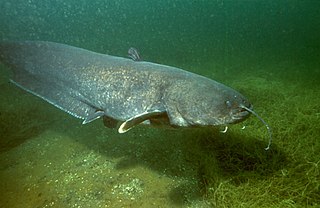
Lake Tanganyika is an African Great Lake. It is the second-largest freshwater lake by volume and the second deepest, in both cases after Lake Baikal in Siberia. It is the world's longest freshwater lake. The lake is shared among four countries—Tanzania, the Democratic Republic of the Congo, Burundi, and Zambia—with Tanzania (46%) and the DRC (40%) possessing the majority of the lake. It drains into the Congo River system and ultimately into the Atlantic Ocean.

The flathead catfish, also called by several common names including mudcat or shovelhead cat, is a large species of North American freshwater catfish in the family Ictaluridae. It is the only species of the genus Pylodictis. Ranging from the lower Great Lakes region to northern Mexico, it has been widely introduced and is an invasive species in some areas. The closest living relative of the flathead catfish is the much smaller widemouth blindcat, Satan eurystomus, a cavefish.

The iridescent shark or iridescent shark catfish is a species of shark catfish native to the rivers of Southeast Asia. Despite its name, it is not a shark. It is found in the Mekong basin as well as the Chao Phraya River, and is heavily cultivated for food there.

The blue catfish is a large species of North American catfish, reaching a length of 65 in (170 cm) and a weight of 143 lb (65 kg). The continent’s largest catfish, it can live to 20 years, with a typical fish being between 25–46 in (64–117 cm) and 30–70 lb (14–32 kg). Native distribution is primarily in the Mississippi River and Louisiana drainage systems, including the Missouri, Ohio, Tennessee, and Arkansas Rivers, the Des Moines River in south-central Iowa, the Rio Grande, and south along the Gulf Coast to Belize and Guatemala.

The Mekong giant catfish, is a large, threatened species of catfish in the shark catfish family (Pangasiidae), native to the Mekong basin in Southeast Asia and adjacent China. It is considered critically endangered due to overfishing and habitat loss.

The giant otter or giant river otter is a South American carnivorous mammal. It is the longest member of the weasel family, Mustelidae, a globally successful group of predators, reaching up to 1.8 m. Atypical of mustelids, the giant otter is a social species, with family groups typically supporting three to eight members. The groups are centered on a dominant breeding pair and are extremely cohesive and cooperative. Although generally peaceful, the species is territorial, and aggression has been observed between groups. The giant otter is diurnal, being active exclusively during daylight hours. It is the noisiest otter species, and distinct vocalizations have been documented that indicate alarm, aggression, and reassurance.

The gafftopsail catfish is a species of marine catfish found in the waters of the western central Atlantic Ocean, as well as the Gulf of Mexico and the Caribbean Sea. It has long, venomous spines which can cause painful wounds. It feeds on crustaceans and other fish. The male of the species fertilizes the eggs of the female, and broods them in his mouth until they hatch. The gafftopsail feeds throughout the water column. This fish is a common catch in the Southeastern US, although it may be found as far north as New York. They are considered strong fighters by anglers. They are taken from piers, jetties, reefs, and the surf, as well as bottom fishing or flats fishing. They are caught with hard lures as well as soft plastics, cut bait, and live or dead shrimp. Some fishermen use traps for catfish, a method regulated by some states.

The wels catfish, also called sheatfish or just wels, is a large species of catfish native to wide areas of central, southern, and eastern Europe, in the basins of the Baltic, Black and Caspian Seas. It has been introduced to Western Europe as a prized sport fish and is now found from the United Kingdom east to Kazakhstan and China and south to Greece and Turkey.

The redtail catfish, is a large species of South American pimelodid (long-whiskered) catfish. It is known in Venezuelan Spanish as cajaro; in Guyana, it is known as a banana catfish, and in Brazil it is known as pirarara, a fusion of words from the indigenous Tupi language: pirá and arara. It is the only extant species of its genus, Phractocephalus.

Wallago attu, the Sareng catfish is a freshwater catfish of the family Siluridae, native to South and Southeast Asia. W. attu is found in large rivers and lakes in two geographically disconnected regions, with one population living over much of the Indian Subcontinent and the other in parts of Southeast Asia. This species can reach a length up to 1.1 m.
Sperata is a genus of bagrid catfishes.
Pardiglanis tarabinii, the Somalian giant catfish, is a species of claroteid catfish native to Kenya and Somalia.

The giant pangasius, paroon shark, pangasid-catfish or Chao Phraya giant catfish is a species of freshwater fish in the shark catfish family (Pangasiidae) of order Siluriformes, found in the Chao Phraya and Mekong basins in Indochina. Its populations have declined drastically, mainly due to overfishing, and it is now considered Critically Endangered.

Cavefish or cave fish is a generic term for fresh and brackish water fish adapted to life in caves and other underground habitats. Related terms are subterranean fish, troglomorphic fish, troglobitic fish, stygobitic fish, phreatic fish, and hypogean fish.
Sperata acicularis is a species of bagrid catfish endemic to Myanmar where it is found in the Irrawaddy, Bago, and Great Tenasserim River systems of Myanmar.

Sperata aor, the long-whiskered catfish, is a species of catfish of the family Bagridae found in southern Asia in the nations of India, Pakistan, Nepal, Bangladesh and Myanmar. It grows to a length of 180 centimetres (71 in) and is commercially fished for human consumption. It is also a popular gamefish.
Sperata aorella is a species of bagrid catfish that occurs in the Ganges River in India and Bangladesh.
Bagarius bagarius, also known as the giant devil catfish or goonch, is a species of catfish in the genus Bagarius. It is generally reported as being found in large and medium rivers in South Asia, and is likely synonymous with B. yarrelli.

Bagarius yarrelli, also known as the goonch catfish, giant devil catfish, or simply Goonch, is a very large species of catfish in the genus Bagarius found in rivers in the Indian subcontinent. The species reaches up to 2 m (6.6 ft) in length. It may be synonymous with B. bagarius.

















